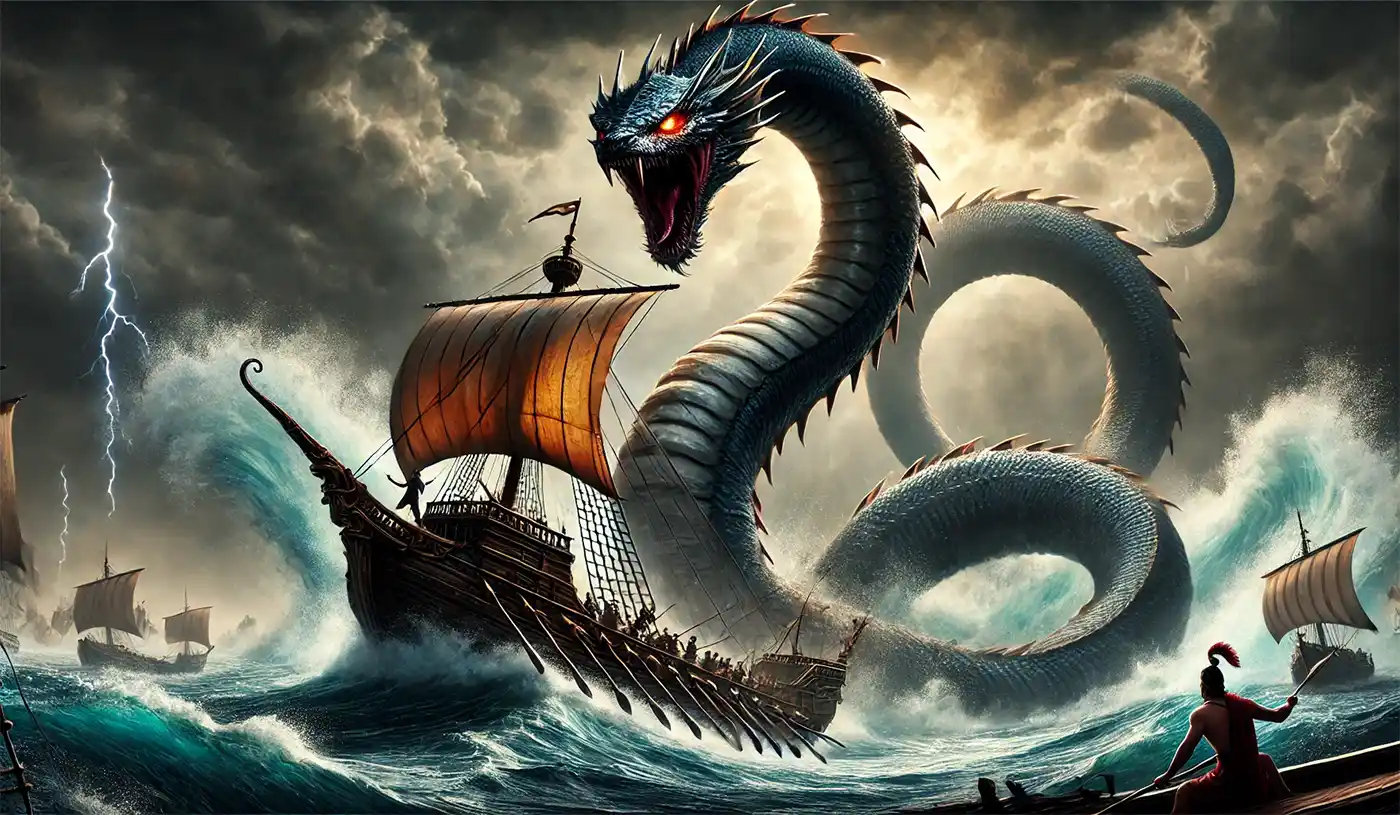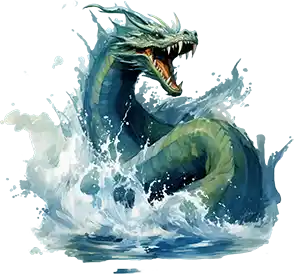Celebrating the Mysteries of the Deep
August 7th is National Sea Serpent Day, a day dedicated to the legendary creatures that have captured human imagination for centuries. From ancient myths to modern sightings, sea serpents have slithered their way into folklore, literature, and popular culture. Let's dive into the deep, murky waters of sea serpent lore and explore the fascinating world of these elusive monsters.
The Origins of Sea Serpent Legends
Sea serpent legends date back to ancient times, with some of the earliest accounts coming from Greek and Norse mythology. In Greek mythology, the Hydra was a multi-headed serpent slain by Hercules as one of his twelve labors. Meanwhile, Norse mythology tells of Jörmungandr, the Midgard Serpent, a colossal beast that encircles the world and is destined to battle Thor during Ragnarok.
Throughout history, sailors and explorers have reported sightings of massive, serpentine creatures lurking beneath the waves. These accounts often describe creatures with long, snake-like bodies, enormous heads, and scales glistening in the sunlight. The stories spread quickly, feeding the imagination and fear of seafarers across the globe.

Notable Sea Serpent Sightings
The Kraken: While technically more of a giant squid than a serpent, the Kraken has been a staple of sea monster lore. First mentioned in Norse sagas, the Kraken was said to be so large that it could engulf entire ships with its tentacles. Its legend grew over the centuries, inspiring countless tales of terror on the high seas.
The Gloucester Sea Serpent: One of the most famous sea serpent sightings occurred off the coast of Gloucester, Massachusetts, in the early 19th century. Witnesses described a creature over 100 feet long, with humps and a horse-like head. The Gloucester Sea Serpent was spotted multiple times over several years, sparking debates and intrigue.
The Cadborosaurus: Named after Cadboro Bay in British Columbia, Cadborosaurus is a sea serpent allegedly seen along the Pacific coast of North America. Descriptions of Caddy, as it’s affectionately known, often include a long neck, a horse-like head, and a serpentine body. While no definitive evidence exists, the legend of Cadborosaurus continues to captivate locals and tourists alike.
 The Science Behind Sea Serpents
The Science Behind Sea Serpents
While the existence of sea serpents remains unproven, several scientific explanations have been proposed for these sightings. Many believe that misidentifications of known marine animals, such as whales, giant squids, or large eels, could account for the reports. For instance, a surfacing whale might appear serpentine from a distance, with its undulating body creating the illusion of a multi-humped creature.
Others suggest that ancient, long-extinct marine reptiles, like the plesiosaur, could be the basis for sea serpent legends. Fossils of these creatures reveal that they had long necks and streamlined bodies, fitting many descriptions of sea serpents.
Fun Facts About Sea Serpents
- Oldest Legends: The oldest known sea serpent legend comes from the Babylonian myth of Tiamat, a primordial sea goddess often depicted as a massive serpent or dragon.
- Cultural Impact: Sea serpents have influenced literature and art for centuries, appearing in works like Herman Melville's "Moby-Dick" and Jules Verne's "Twenty Thousand Leagues Under the Sea."
- Modern Media: Sea serpents continue to slither into popular culture, featuring in movies like "The Water Horse" and TV shows like "Game of Thrones."
- Cryptozoology: The study of sea serpents falls under the realm of cryptozoology, a field dedicated to investigating creatures that are not recognized by mainstream science.
Celebrating National Sea Serpent Day
Dive into Literature: Spend the day reading about sea serpents in mythology and fiction. From ancient texts to modern novels, there’s no shortage of sea serpent stories to explore.
Watch a Movie: Pop some popcorn and watch a sea serpent-themed movie. Whether it's a documentary about mythical creatures or a thrilling fantasy film, there's something for everyone.
Create Your Own Sea Serpent: Get creative and draw or sculpt your version of a sea serpent. Let your imagination run wild and see what kind of creature you can conjure up.
Visit a Maritime Museum: If you’re near the coast, visit a maritime museum to learn more about the history of sea serpents and other marine legends.
The Humorous Side of Sea Serpents
Imagine being a sea serpent, the misunderstood celebrity of the ocean. You’re just trying to go about your day—maybe grab a bite of krill or take a leisurely swim—when suddenly, a ship full of humans starts screaming and pointing. “Oh great,” you think, “another group of paparazzi.”
 Or picture a sea serpent family reunion. Cousin Kraken complains about how he’s always mistaken for a squid, while Aunt Nessie talks about her peaceful life in Loch Ness, away from the hustle and bustle of ocean fame. Uncle Cadborosaurus, sipping seaweed tea, chuckles about how he’s managed to stay under the radar all these years.
Or picture a sea serpent family reunion. Cousin Kraken complains about how he’s always mistaken for a squid, while Aunt Nessie talks about her peaceful life in Loch Ness, away from the hustle and bustle of ocean fame. Uncle Cadborosaurus, sipping seaweed tea, chuckles about how he’s managed to stay under the radar all these years.
National Sea Serpent Day is a wonderful opportunity to celebrate the mysterious and enchanting world of sea serpents. These legendary creatures have captured our imaginations for centuries, inspiring countless tales of wonder and fear. Whether you believe in their existence or see them as symbols of the unknown, sea serpents remind us of the vast, unexplored mysteries that still lie beneath the ocean's surface.
So, on this National Sea Serpent Day, take a moment to dive into the legends, enjoy the humor, and let your imagination swim with the serpents of the deep. Happy National Sea Serpent Day!
Please Share our Content







 The Science Behind Sea Serpents
The Science Behind Sea Serpents Or picture a sea serpent family reunion. Cousin Kraken complains about how he’s always mistaken for a squid, while Aunt Nessie talks about her peaceful life in Loch Ness, away from the hustle and bustle of ocean fame. Uncle Cadborosaurus, sipping seaweed tea, chuckles about how he’s managed to stay under the radar all these years.
Or picture a sea serpent family reunion. Cousin Kraken complains about how he’s always mistaken for a squid, while Aunt Nessie talks about her peaceful life in Loch Ness, away from the hustle and bustle of ocean fame. Uncle Cadborosaurus, sipping seaweed tea, chuckles about how he’s managed to stay under the radar all these years.








 "Sláinte!" is a traditional Irish expression used as a toast, equivalent to "Cheers!" in English.
"Sláinte!" is a traditional Irish expression used as a toast, equivalent to "Cheers!" in English.